When spring rolls around, it’s time to give your bonsai a little TLC with proper pruning and repotting. I usually grab quality bonsai shears and start by evaluating the tree’s shape, trimming away unwanted growth. Did you know that pruning not only clears deadwood but also promotes fresh shoots? As for repotting, wait for those enthusiastic buds to pop! Follow my guide for aftercare, and soon you’ll be in harmony with your mini tree. Ready for more bonsai wisdom?
Quick Takeaways
- Spring pruning is vital for bonsai health, clearing deadwood and promoting new growth while shaping the tree’s character.
- Use quality tools like scissors and bonsai shears for effective pruning, and wire cutters for adjustments.
- Follow a step-by-step pruning process: assess shape, remove unwanted growth, and fine-tune foliage for aesthetics.
- Repot in spring when new growth appears, using a well-draining soil mix and securing the bonsai properly in the new pot.
- Establish a consistent watering schedule and begin fertilizing a month post-repotting to support recovery and thriving growth.
Understanding the Importance of Spring Pruning
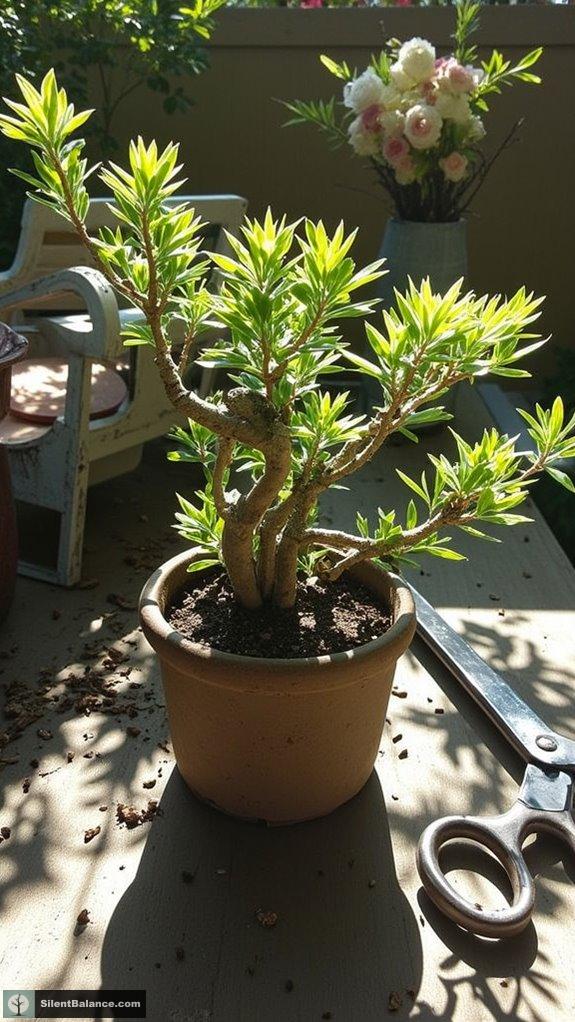
Spring is here, and whether you’re a seasoned tree whisperer or just starting your bonsai journey, you might be wondering, “Why is pruning such a big deal?”
Well, let me tell you: spring pruning is the lifeblood of your bonsai’s health and energy!
Spring pruning breathes life into your bonsai, rejuvenating its health and energy for vibrant growth!
As the seasonal changes usher in fresh spring growth, it’s time to grab your scissors and get to work. Pruning clears away the deadwood and overgrowth, allowing your bonsai to breathe and thrive.
Think of it as a haircut for your little tree friend, promoting new shoots and shaping its character.
Plus, controlling its form gives you a sense of mastery, doesn’t it? Also, incorporating bonsai meditation techniques during the pruning process can deepen your connection to the tree. So, let’s plunge into this delightful process and help your bonsai flourish like the star it is!
Essential Tools for Bonsai Pruning and Repotting
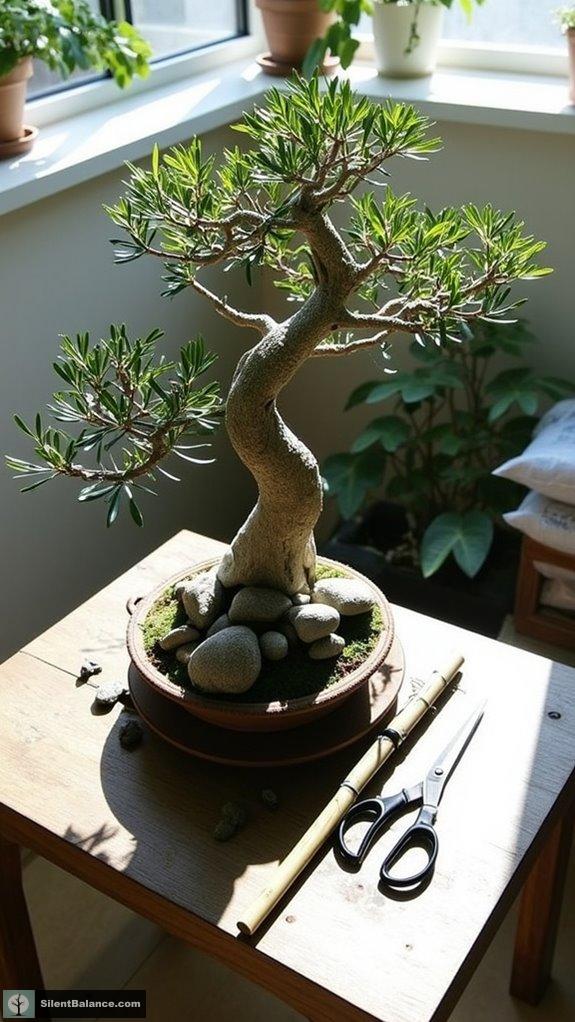
When it comes to bonsai pruning and repotting, having the right tools is just as essential as knowing the techniques themselves. I can’t stress enough how important quality scissors, bonsai shears, and wire cutters are for mastering those pruning techniques you’ve been eyeing.
Make sure to grab a root rake and some fine-fingered tools for repotting strategies; trust me, they’ll save you a headache!
Do you want to avoid damaging those delicate roots? Use a gentle touch!
And let’s not forget about your trusty bamboo sticks for positioning. They’re not just cute; they keep everything in place.
With the right tools in your arsenal, you’ll wield control over your bonsai masterpiece like a pro. Ready to plunge in? Let’s go!
Step-by-Step Guide to Pruning Your Bonsai
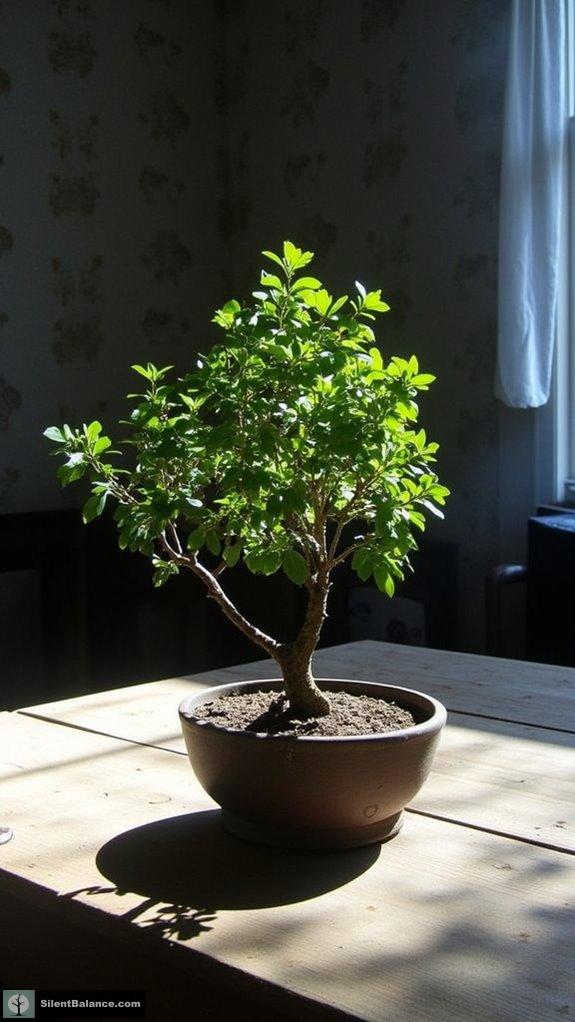
Before diving into the exciting world of bonsai pruning, let’s chat about timing.
Trust me, you want to be precise to achieve those perfect bonsai aesthetics you’ve been dreaming of.
Precision is key to achieving the stunning bonsai aesthetics you’ve always envisioned.
Here’s a step-by-step guide to get you started with some effective pruning techniques:
- Assess your tree: Take a moment to evaluate its shape—what style are you aiming for?
- Remove unwanted growth: Snip off any branches that disrupt the flow, focusing on the trunk line and primary branches.
- Fine-tune: Use your scissors for detailed work, trimming back to promote dense foliage.
Additionally, understanding your bonsai’s species is key to ensuring you prune at the right time and in the right way.
Timing Your Repotting: When and Why
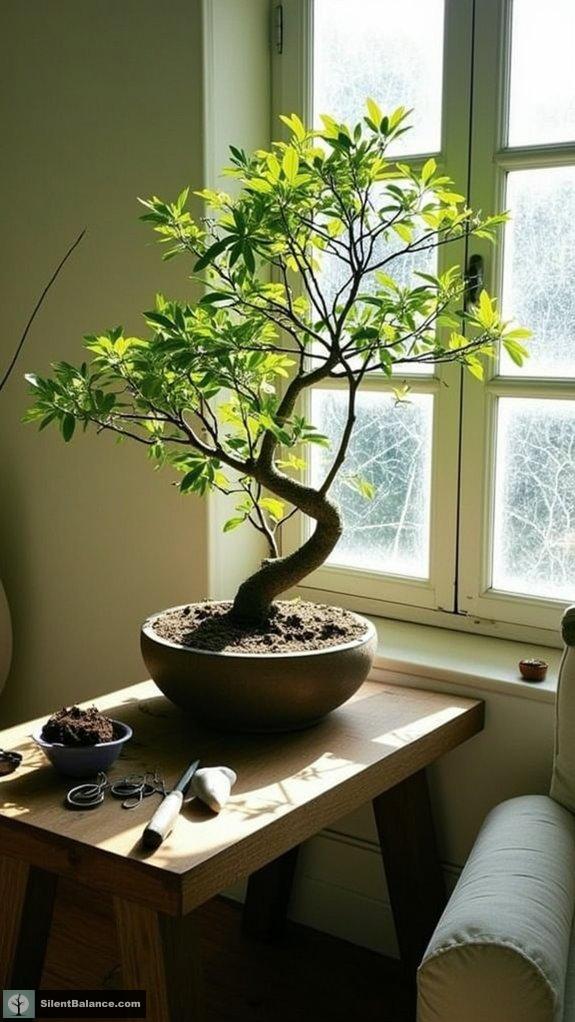
Repotting your bonsai isn’t just a chore; it’s a golden opportunity to give your little tree the fresh start it deserves.
Timing is everything, and I find spring, when new growth begins, is the best time to tackle this task. You want to watch for seasonal indicators like budding leaves or active roots—these signals show your bonsai is ready to thrive in fresh soil.
As for best practices, aim to repot every couple of years, or sooner if you notice roots circling the pot. Indoor vs outdoor bonsai requires different care, so be mindful of your tree’s environment during this process.
Trust me, a timely repot contributes to a vigorous, healthy bonsai, enhancing not just aesthetics but also your connection with this living art.
Ready to give your tree a new home? Let’s do it!
The Repotting Process: Steps to Follow
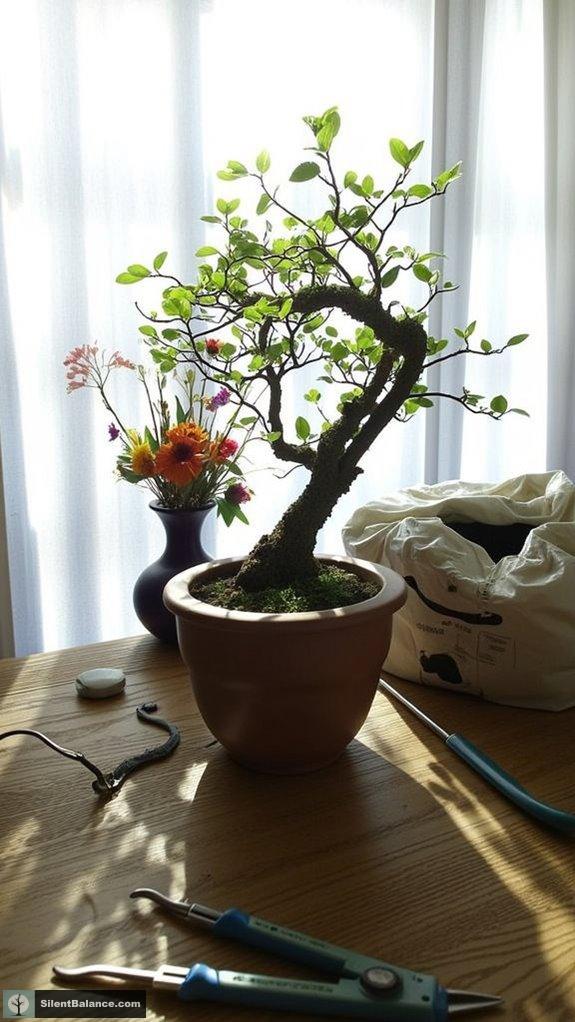
As we immerse ourselves in the nitty-gritty of repotting your bonsai, you’ve got to embrace the fact that this isn’t just a routine task—it’s a transformative experience for both you and your little tree.
Ready to jump in? Let’s apply some solid repotting techniques.
- Gather your tools: A sharp root hook, bonsai shears, and a new pot are essentials for this journey.
- Choose your soil wisely: Go for a mix that promotes drainage while retaining nutrients—think akadama or bonsai soil formulas.
- Head to the pot: When placing your bonsai in its new home, center it and secure it with wire if you’re feeling fancy.
Aftercare Tips for Newly Pruned and Repotted Bonsai
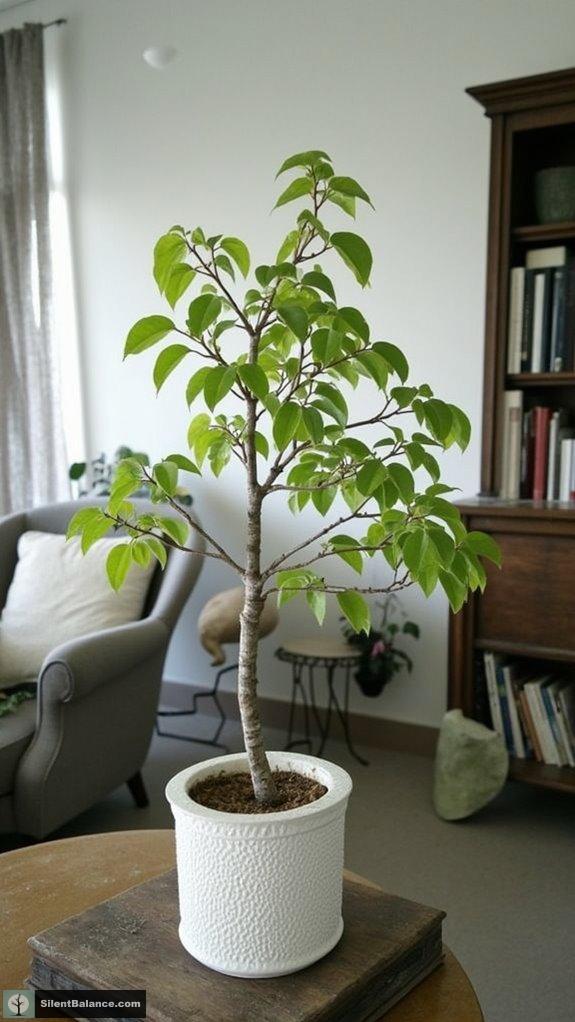
Once you’ve pruned and repotted your bonsai, the adventure doesn’t stop there—it’s just the beginning of a nurturing journey!
Now, it’s time to establish a solid watering schedule. I recommend checking the soil daily; it should be moist but never soggy. Recall, overwatering can be the arch-nemesis of our little trees!
Establish a reliable watering routine; daily soil checks ensure your bonsai stays happy and healthy!
Next, let’s focus on nutrient balance. About a month after repotting, start fertilizing with a balanced solution to support recovery and growth. Think of it as a spa day for your bonsai!
Keep an eye on any new growth—they’re your bonsai’s way of signaling, “Hey, I’m thriving!”
With diligence and a sprinkle of love, your bonsai will flourish beautifully! Ready to plunge in?
Bonsai Tree Symbolism
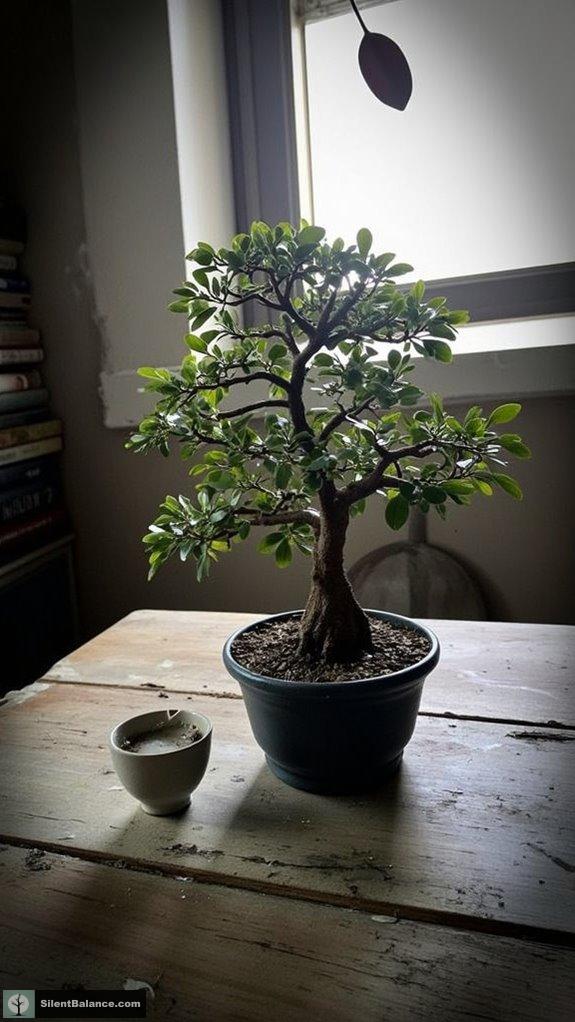
After nurturing your bonsai with love and care, it’s fascinating to explore the profound symbolism these miniature trees carry.
Each bonsai tells a story wrapped in deep cultural significance that can enrich your experience as a caretaker.
Here are some bonsai meanings you might find intriguing:
- Resilience: These trees represent enduring strength, thriving even in the midst of adversity.
- Harmony: The balance between nature and human effort reflects tranquility and inner peace.
- Longevity: Bonsai symbolize a commitment to life, often representing wishes for good health and long life.
Tree Symbolism
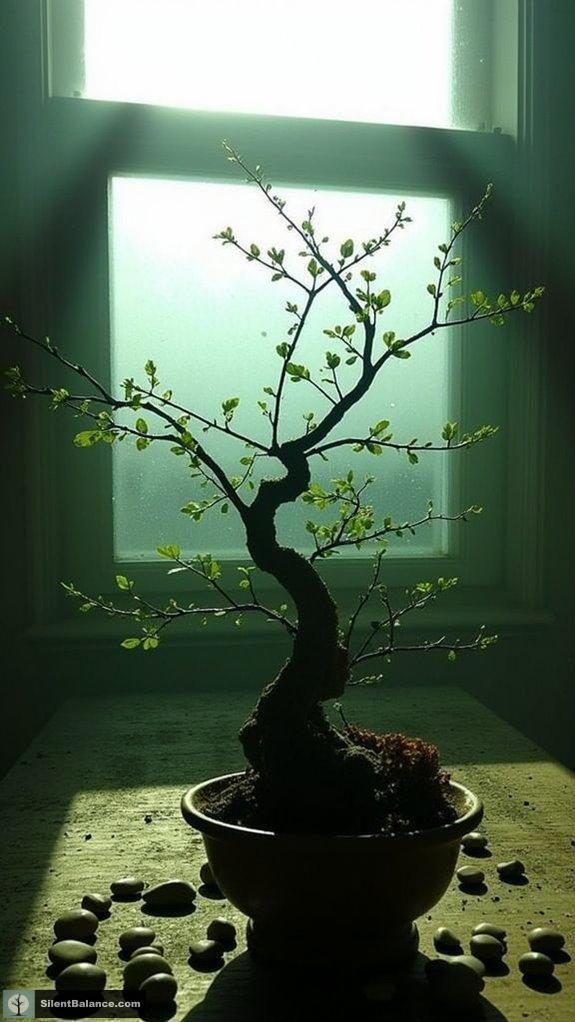
Trees have long been celebrated as symbols of life, strength, and connection to nature, so it’s no surprise that each type of tree carries its own unique meaning.
Trees embody life, strength, and nature’s connection, each uniquely representing profound meanings and stories waiting to be uncovered.
Think about it: the bonsai represents patience and harmony while the willow whispers of adaptability and resilience.
Their spiritual significance often ties back to cultural meanings—like how the oak symbolizes stability and wisdom across various traditions.
When we prune or repot, we’re not just caring for our trees; we’re cultivating a deeper connection to this potent symbolism.
Ever thought about the stories your bonsai might tell?
Questions and Answers
Can I Prune My Bonsai in Winter Instead of Spring?
You might be wondering if you can prune your bonsai in winter instead of spring, huh?
While I get the urge to snip during Bonsai winter care, it’s typically not ideal.
Most species enter dormancy then, making them less responsive to pruning techniques.
It’s best to wait until they wake up in spring.
I promise, your little tree will thank you for holding off!
Patience is key in this lovely art form.
How Long Does the Bonsai Recovery Process Usually Take?
When it comes to bonsai recovery, patience is key—it’s not a sprint, it’s a marathon.
Typically, you’ll see recovery signs within a few weeks, but full restoration can take a few months.
To speed things along, I’ve got some recovery tips: guarantee proper watering, provide bright but indirect light, and keep an eye on humidity levels.
Remember, every tree’s unique.
What’s the Ideal Soil Mix for Repotting Bonsai?
When repotting your bonsai, the ideal soil mix is essential for success. I usually combine a good quality bonsai soil with components like Akadama, pumice, and lava rock.
This blend guarantees excellent bonsai drainage, promoting healthy root growth while retaining just the right amount of moisture.
Have you ever wondered how a good mix can elevate your bonsai game? Trust me, nailing this step makes all the difference for your little tree!
Are There Any Bonsai Species That Require Special Care During Repotting?
Ah, the world of bonsai! It’s fascinating how each species has its quirks.
When repotting, Japanese Maples need tender care since they’re quite picky about soil drainage.
Pine Bonsai also require some special attention, as they prefer a free-draining mix.
Tropical species? Don’t get me started! They thrive in warmer climes but can sulk in cooler soil conditions.
How Can I Tell if My Bonsai Needs to Be Repotted?
To figure out if your bonsai needs repotting, I look for signs of root health.
If the roots are popping out of the drainage holes or the soil dries out too quickly, it’s time.
Check the repot timing too; early spring is ideal before new buds appear.
Don’t ignore those moisture-loving roots!
So, when’s your bonsai’s last spa day?
Give it a little pampering; it deserves it!
Summary
So, as we wrap up our bonsai adventure, recall that pruning and repotting isn’t just maintenance; it’s like giving your tree a haircut and a fresh pair of shoes! Tending to your bonsai with care and patience fosters its growth and elegance. Keep your tools sharp and your spirit high, and soon, you’ll find your little green friend thriving. Ready to embrace the zen art of bonsai? Let’s keep cultivating that connection, one trim at a time!
- Bonsai Trees: Structural and Maintenance Pruning Differences - September 8, 2025
- 5 Essential Pruning Tips for Balanced Bonsai Tree Growth - September 8, 2025
- Mastering Precise Pruning for Bonsai Trees - September 8, 2025

